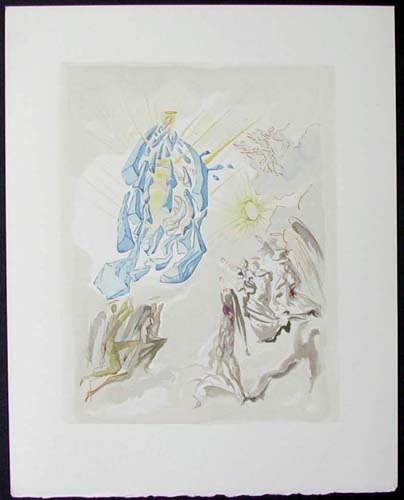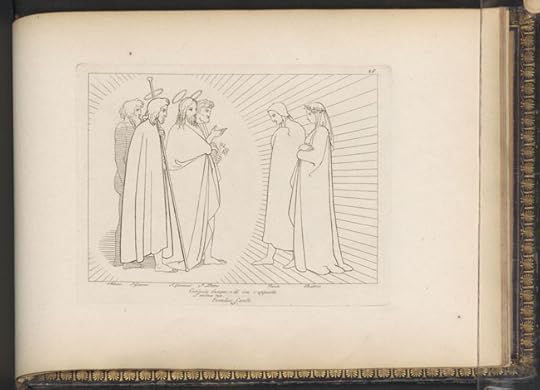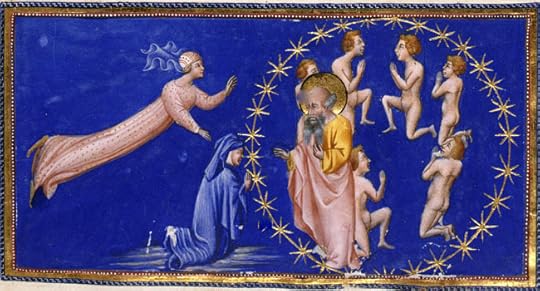Classics and the Western Canon discussion
Divine Comedy, Dante
>
Paradiso 26: St. John Questions Dante Concerning Love/Adam Answers Dante's Questions
date newest »
newest »
 newest »
newest »
 http://www.lockportstreetgallery.com/...
http://www.lockportstreetgallery.com/...
Salvador Dali: Paradiso Canto 26. ”The Apotheosis of the Virgin Mary.”
Apotheosis: "the elevation of a human to the rank of a god: the raising of a person or thing to divine status."
 http://www.worldofdante.org/media/ima...
http://www.worldofdante.org/media/ima...
Gustave Doré: Paradiso Canto XXVI.4. “St. John Examines Dante on Love.” c.1868. Engraving.
 http://www.worldofdante.org/media/ima...
http://www.worldofdante.org/media/ima...
Sandro Botticelli: Paradiso Canto XXVI.1. “Eighth Sphere (Heaven of Fixed Stars); St.'John Questions Dante on the Third Theological Virtue—Love. Dante Regains His Sight, Stronger than Before; The Light of Adam Appears.” c.1480 - c.1495. Drawing.
 http://www.worldofdante.org/media/ima...
http://www.worldofdante.org/media/ima...
John Flaxman: Paradiso Canto XXVI.4. “St. John’s Examination of Dante.” 1793. Engraving.
 http://www.worldofdante.org/media/ima...
http://www.worldofdante.org/media/ima...
Giovanni di Paolo: Paradiso Canto XXVI.7. “St. John Examines Dante on Love.” c.1450. Manuscript illumination. Yates Thompson 36. British Library.
 http://www.worldofdante.org/media/ima...
http://www.worldofdante.org/media/ima...
Giovanni di Paolo: Paradiso Canto XXVI.103. “Adam Addresses Dante in the Heaven of Fixed Stars.” c.1450. Manuscript illumination. Yates Thompson 36. British Library.
 http://etcweb.princeton.edu/dante/pdp...
http://etcweb.princeton.edu/dante/pdp...
Amos Nattini: Paradiso Canto XXVI. "Mentr'io dubbiava per lo viso spento, 1923. (First line. In Hollander translation, that becomes “While I was still bewildered at my loss of sight,…”)
No Nattini images available for Cantos 27-29.
 Paradiso is awefully didactic, isn't it? Dante is summoned to the Sphere of the Fixed Stars, meets Adam, and his burning question is what language was spoken in Eden. That wouldn't be the number one thing on my mind. It seems like that's put in to give the reader a little Scholastic lesson.
Paradiso is awefully didactic, isn't it? Dante is summoned to the Sphere of the Fixed Stars, meets Adam, and his burning question is what language was spoken in Eden. That wouldn't be the number one thing on my mind. It seems like that's put in to give the reader a little Scholastic lesson.
 Roger wrote: "Paradiso is awefully didactic, isn't it? Dante is summoned to the Sphere of the Fixed Stars, meets Adam, and his burning question is what language was spoken in Eden. That wouldn't be the number ..."
Roger wrote: "Paradiso is awefully didactic, isn't it? Dante is summoned to the Sphere of the Fixed Stars, meets Adam, and his burning question is what language was spoken in Eden. That wouldn't be the number ..."LoL! Tower of Babel question? Maybe Dante is thinking about his having written his poem in Italian rather than Latin?
 Amazing though that it only took six hours to get kicked out of Eden. That is an interesting detail.
Amazing though that it only took six hours to get kicked out of Eden. That is an interesting detail.
 Thomas wrote: "Amazing though that it only took six hours to get kicked out of Eden. That is an interesting detail."
Thomas wrote: "Amazing though that it only took six hours to get kicked out of Eden. That is an interesting detail."I think they were there for many years before the Fall.
 Laurele wrote: "Thomas wrote: "Amazing though that it only took six hours to get kicked out of Eden. That is an interesting detail."
Laurele wrote: "Thomas wrote: "Amazing though that it only took six hours to get kicked out of Eden. That is an interesting detail."I think they were there for many years before the Fall."
I'm not sure Dante agrees. Adam answers the pilgrim's question in astronomical (solar) terms. Unless I'm reading this incorrectly, I think he is suggesting here the time he lived "pure" was very short.
On the mountain which rises highest from the sea
I lived pure, then guilty,
from the first hour to that which follows,
when the sun changed quadrant, next upon the sixth.
From the first hour to when the sun changes quadrant is six hours. The mountain is Purgatory, or what would become Purgatory, at the top of which is the Terrestrial Paradise. Adam lived for another 930 years in exile and after his death was in Limbo for 4302 years.
I have no idea how Dante figures this -- it seems an awfully short amount of time to get into so much trouble.
 Thomas wrote: "Laurele wrote: "Thomas wrote: "Amazing though that it only took six hours to get kicked out of Eden. That is an interesting detail."
Thomas wrote: "Laurele wrote: "Thomas wrote: "Amazing though that it only took six hours to get kicked out of Eden. That is an interesting detail."I think they were there for many years before the Fall."
I'm n..."
Right. I'm just disagreeing with Dante.
 Evidently Dante gets his chronological information from a fellow named Petrus Comestor, a French medieval theologian.
Evidently Dante gets his chronological information from a fellow named Petrus Comestor, a French medieval theologian. Wiki:
"The surname of "Comestor" ("devourer"), given to Peter during his life, also demonstrates the esteem in which his learning was held: he was a great bookworm. He often refers to his surname in his sermons and in the epitaph said to be composed by him: "Petrus eram ... dictusque comestor, nunc comedor." ("Peter was I... and called the devourer: now I am eaten.")
His Historia Scholastica is a kind of sacred history composed for students. The author begins the sacred narrative at the Creation, and continues it to the end of the incidents related in the Acts of the Apostles; all the books of the Bible are contained therein...
He borrows frequently from profane authors, especially from Flavius Josephus for the beginning of the Gospels, and very often the test is as though paraphrased in a commentary where all data, cosmological and physical, philosophical, theological, geographical, etc., are found. There are numerous inaccuracies and fables."
 Thomas wrote: "Evidently Dante gets his chronological information from a fellow named Petrus Comestor, a French medieval theologian.
Thomas wrote: "Evidently Dante gets his chronological information from a fellow named Petrus Comestor, a French medieval theologian. Wiki:
"The surname of "Comestor" ("devourer"), given to Peter during his lif..."
Very interesting, Thomas.
 In this thread we have all our artists represented. Overall, I say none of them are satisfactory. Dore is the best; he captures the grandeur of the vision, but he needs color to show the richness of Paradise, and he uses anthropomorphic figures even here, where Dante tells us the blessed appear as radiant beings. Dali is distorted and strange. The Botticelli drawing are repetitive and boring circles (to be fair they are only cartoons lacking intended color--but maybe there's a reason Botticelli never painted them, too). The medieval illuminations are awkward and static. Flaxman is static, flat, and anthropomorphic. Nattini's flying figures are just ridiculous--they look like theatrical Peter Pans suspended from cables. I'm beginning to think that we just can't visualize heaven. Maybe Dante would agree.
In this thread we have all our artists represented. Overall, I say none of them are satisfactory. Dore is the best; he captures the grandeur of the vision, but he needs color to show the richness of Paradise, and he uses anthropomorphic figures even here, where Dante tells us the blessed appear as radiant beings. Dali is distorted and strange. The Botticelli drawing are repetitive and boring circles (to be fair they are only cartoons lacking intended color--but maybe there's a reason Botticelli never painted them, too). The medieval illuminations are awkward and static. Flaxman is static, flat, and anthropomorphic. Nattini's flying figures are just ridiculous--they look like theatrical Peter Pans suspended from cables. I'm beginning to think that we just can't visualize heaven. Maybe Dante would agree.
 Roger wrote: "In this thread we have all our artists represented. Overall, I say none of them are satisfactory...."
Roger wrote: "In this thread we have all our artists represented. Overall, I say none of them are satisfactory...."Well, not quite all -- there are others that I've not even tried to post throughout and neither the Bodleian manuscript nor Ivo David nor Blake is here for Canto 26. But, while I would agree with your assessment, Roger, that overall none of them is satisfactory, having lived rather closely with each of them for several weeks now, I may have a more motherly and protective attitude towards these artists than your probably more unbiased critical eye. I'll comment here on a couple and perhaps later on others.
The Botticelli drawings are perhaps the biggest disappointment for me. Sometimes I don't even trust the source from which I have been linking these. Other times I feel as if only the prestige of the artist prevented these apparently incomplete drawings from being destroyed. Only a very few are available with any of the intended color -- as far as I have read so far, there was never an intent to move them from cartoons to paintings, but color was intended. It is almost like looking at a project in which this great artist overextended himself. I'm not going looking for the full story right now, but it is one for which I will stay aware for fragments and sources. Of all the groups of illustrations followed, seeing an original of one of these, even one of the most incomplete, is probably highest on my wish list.
The other I'll comment on now is the medieval drawings -- yes, they are awkward and static. But, I have come to imagine a room of monks, ala the movie of Eco's The Name of the Rose, laboring for months over these tiny illustrations and the manuscript in which they were embedded. How many of those monks ever read Commedia? Who was the moneyed lord for whom they were created? Who decided what each picture would be? Why were certain figures clipped from the original? Where are the pages that seem to be missing? Which figure is whom? What aspect of this particular canto does the figure at hand capture? How rich the colors are. (One of the overall feelings that has come from the Bodleian manuscript has been the sense of dialogue that does indeed permeate Dante's journey.)
For now....
Meanwhile, I'll totally agree "that we just can't visualize heaven." Yet, if we are ever to consider legitimate the challenge of "on Earth as it is in Heaven"....
 I came across this comment from T.S. Eliot (while searching for something else):
I came across this comment from T.S. Eliot (while searching for something else): "Dante, more than any other poet, has succeeded in dealing with his philosophy, not as a theory...or as his own comment or reflection, but in terms of something perceived."
I'm finding these last cantos really slow going, very tough reading, because I can't easily visualize what Dante is describing. He's expressing his theology as a vision, but for whatever reason I can't see the correlation between his vision as he describes it and the underlying philosophy. I think part of it is the translation issue, but I think it's also the enormity of what Dante is attempting.
 Thomas wrote: "I came across this comment from T.S. Eliot (while searching for something else):
Thomas wrote: "I came across this comment from T.S. Eliot (while searching for something else): "Dante, more than any other poet, has succeeded in dealing with his philosophy, not as a theory...or as his own co..."
He's trying to describe the undiscribable. It's something we can't understand til we see it, and then it might not be a matter for understanding.
 Laurele wrote: "He's trying to describe the undiscribable. It's something we can't understand til we see it, and then it might not be a matter for understanding.
Laurele wrote: "He's trying to describe the undiscribable. It's something we can't understand til we see it, and then it might not be a matter for understanding. "
Yes, and it's remarkable that we have artists who go even further and try to paint the indescribable. It's either extremely courageous, or naive. But for an artist, perhaps irresistible.
 Thomas wrote: "Yes, and it's remarkable that we have artists who go even further and try to paint the indescribable. It's either extremely courageous, or naive. But for an artist, perhaps irresistible.""
Thomas wrote: "Yes, and it's remarkable that we have artists who go even further and try to paint the indescribable. It's either extremely courageous, or naive. But for an artist, perhaps irresistible.""Yes, and I am not sure it was any less courageous to make the attempt with words. Part of the reason I pull in the NASA images is that I find myself asking what is left after seven centuries.
In only about the third read -- recently mainly without going to the notes (another matter entirely) am I beginning to find things, and they largely are not in any grand overarching philosophy, but rather the tangible links to the everyday. But there is also something beguiling about making the journey and encountering the visions. At one level, I understand why Paradiso is apparently the least read today. At another level, I am very sorry if that is true.
 http://www.blakearchive.org/blake/ima...
http://www.blakearchive.org/blake/ima...
William Blake: Paradiso Canto XXVI. "St. Peter and St. James with Dante and Beatrice and St. John Also." c. 1824-27.



To Dante, bewildered and alarmed by his sudden blindness, come the reassuring words of St John: his sight will be restored to him by the healing gaze of Beatrice. Meanwhile the Apostle questions him concerning love. Dante declares that God is the beginning and end of all his loves and, in response to further questioning, indicates the sources whence he has derived the knowledge that God is the ultimate good, and hence the supreme object of love. Replying still further, he enumerates the blessings by which God manifests His goodness to man. As he concludes, a hymn of praise is sung by all the assembled saints and Dante’s vision is restored. The soul of Adam joins the three Apostles and replies to Dante’s unspoken questions concerning the Fall, the duration of his stay in Eden and of his life on earth, and the language which he spoke.